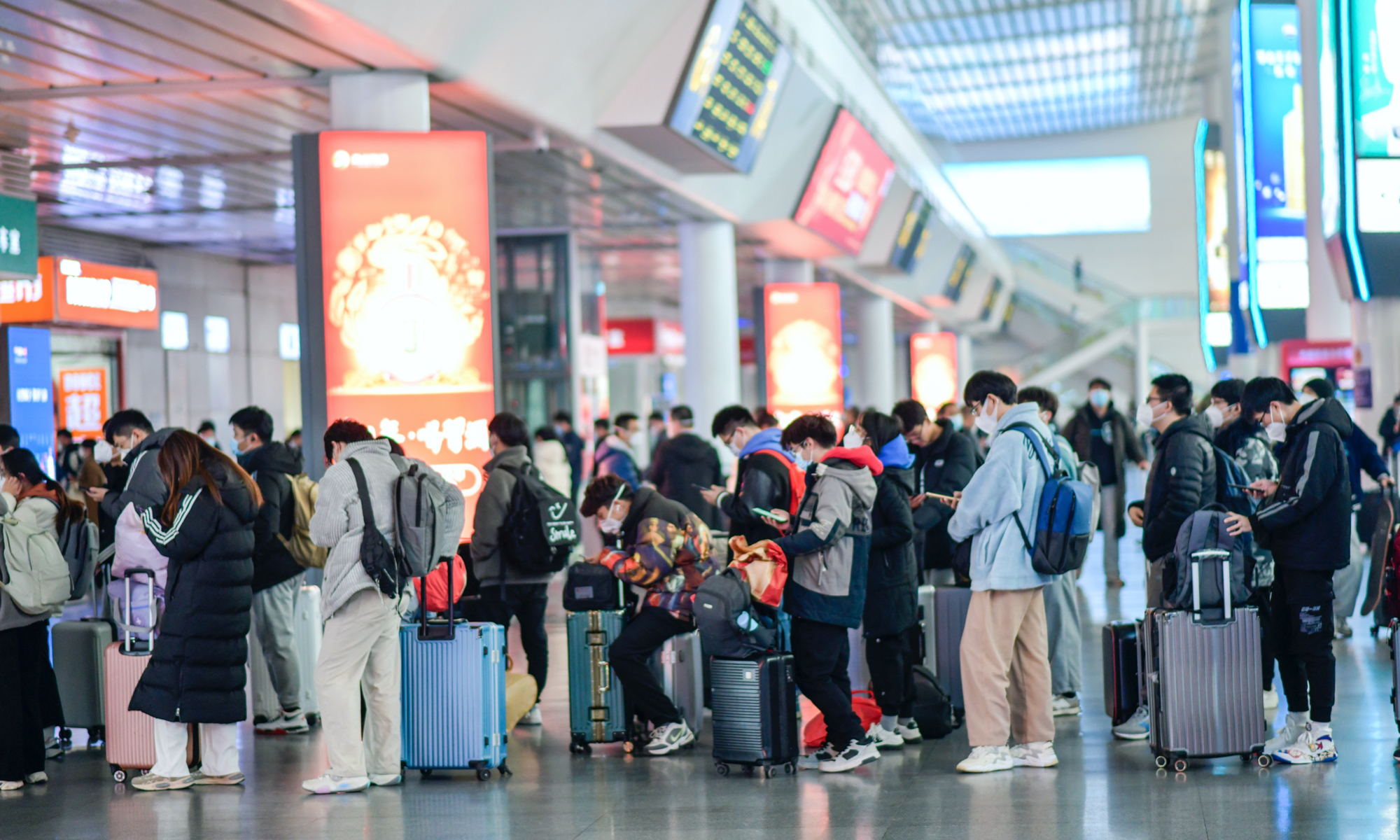
Long lines are seen back at a train station in Jinan, East China’s Shandong Province, on December 7, 2022, as China further optimized COVID response and relaxed controls. Photo: IC
China further adjusted and optimized its COVID-19 response by releasing 10 new measures on Wednesday, including allowing asymptomatic carriers and patients with mild symptoms and those who meet certain requirements to quarantine at home. China’s top health officials said these optimized measures do not signal a full relaxation, rather it is a comprehensive consideration based on experiences accumulated in response to the new characteristics of the virus.
The State Council’s joint prevention and control mechanism against COVID-19 released a new 10-point plan to further optimize the country’s COVID response, including reducing the frequency of nucleic acid testing, scrapping negative nucleic acid result and health code requirements for entering public places except for designated locations, as well as lifting COVID testing and health code requirements for domestic cross-region travel.
The new measures detail that infected individuals with mild or no symptoms who meet the requirements will be allowed to quarantine at home, although they can still choose to go a collective quarantine facility.
The latest optimization comes after the country released 20 measures in mid-November to shorten quarantine periods for international arrivals and close contacts of confirmed cases, in addition to other optimized measures, such as scrapping circuit breakers for inbound flights and stopping screening secondary contacts. The 10 new measures, mainly targeting domestic epidemic control work, were released after health authorities comprehensively evaluated the current prevention and control measures and experiences, as well as existing problems especially after the 20 measures took effect in accordance to the characteristics of the virus variant and epidemic situation, Chinese public health officials said.
“China has continuously adjusted and optimized COVID prevention and control measures with each optimization based on in-depth research and previous experience,” Wang Hesheng, director of the National Administration of Disease Control and Prevention, told a press conference on Wednesday.
Every optimization related to COVID measures emphasizes a scientific and precise manner, focusing on the characteristics of the virus, in line with changes to the international and domestic situation. Every move has been people-centered, he said.
Some public health experts said the 10 measures are important steps toward a more precise and scientific direction of COVID prevention and control measures, as the prevalence of the Omicron mutant strain and its evolutionary branches made the previous epidemic prevention approach too costly and it eventually became ineffective. Now, we need to continuously adjust and optimize the epidemic prevention work to allocate strained medical resources to those in need and focus on vulnerable populations, they said.
Not ‘lying flat’
The latest measures are expected to give a huge boost to cross-region travel as online searches and bookings of flights and train tickets skyrocketed in the immediate wake of the announcement. Ticket searches for the impending 2023 Spring Festival in January hit a three-year high on a number of travel platforms.
Across the country, there are palpable signs of strong recovery in the domestic tourism sector. China’s railway operator announced on Wednesday that railway stations across the country will no longer check 48-hour valid nucleic acid test results and health codes when buying tickets and entering the train stations. Some airports in Beijing and Guangzhou, South China’s Guangdong Province, announced similar measures.
The latest optimized measures do not signal a full relaxation but they are a broad response based on the experience China has accumulated and in consideration to the new characteristics of the coronavirus, aiming to efficiently allocate resources, and a coordinated control and development approach, Liang Wannian, head of the COVID-19 response expert panel under the National Health Commission (NHC), said during the press conference.
China has recorded surging domestic COVID-19 infections in recent weeks, particularly some major cities such as Beijing, Guangzhou and Chongqing.
Adjustment and optimization do not mean letting the epidemic grow out of control, officials and experts said, as China has been taking small steps forward by adjusting in a dynamic way. “If the epidemic becomes severe and heavily affects social functioning, we would probably take relatively stricter measures,” Li Tongzeng, a medical expert at Beijing's Xiaotangshan Hospital, told the Global Times.
“As for now, it’s fully opening because we need to adjust in accordance to the mutation of the virus, the severity of the epidemic, the capacity of the hospital, and the pressure from all aspects of society,” Li said.
Future focus
While most public places no longer require nucleic acid test results and health codes, designated locations such as nursing homes, welfare homes, medical institutions, childcare facilities, and primary and secondary schools still require tests, a targeted move to protect highly vulnerable populations as the next focus in China’s epidemic work.
“Places such as nursing homes, medical institutions and schools are still required to check negative nucleic acid test results and health codes, which is very important as those are places where high risk groups gather, and we should prevent transmission inside hospitals to reduce secondary medical disasters,” Chen Xi, an assistant professor of public health at Yale University, told the Global Times on Wednesday.
The new measures also underline the need to accelerate vaccination rates especially for those aged between 60 to 79 years old, and those 80 or above, noting that special arrangements should be put in place. Vaccination sites should be established to assist seniors.
In mobilizing more elderly people to get vaccinated, China could learn from other countries’ experiences including collecting adverse reactions from both individuals and medical institutions and regularly releasing that information to society to dispel public doubts about vaccines, Chen noted.
“China could also adopt a more reasonable incentive mechanism and gradually opening up through establishing mechanism such as vaccine passports,” he said.
Allowing some infected people to quarantine at home will also help relieve strained medical resources, allocating resources from people with low risk of serious illness and death to high-risk groups.
Compared with the wild type and other mutant strains of concern, the virulence of the mutant strain of Omicron is greatly reduced. Most infected people are asymptomatic or mildly infected with symptoms such as fever and cough, so little medical intervention is required, making home quarantine possible, Lan Ke, director of the State Key Laboratory of Virology at Wuhan University, told the Global Times.
“Omicron’s super transmission power may lead to a short-term increase in the number of infected people, causing the "fangcang” makeshift hospitals to operate at full capacity. So home quarantine is a better choice which leaves limited resources to those who need more,” Lan said.
In response to a question about whether China will adjust epidemic measures for international arrivals, NHC spokesperson Mi Feng said on Wednesday the latest optimization mainly targets domestic epidemic control work and China will gradually optimize measures for international arrivals.

